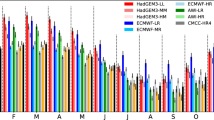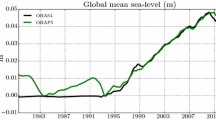Abstract
We discuss the state of Arctic sea ice in the global eddy-permitting ocean reanalysis Ocean ReAnalysis Pilot 5 (ORAP5). Among other innovations, ORAP5 now assimilates observations of sea ice concentration using a univariate 3DVar-FGAT scheme. We focus on the period 1993–2012 and emphasize the evaluation of model performance with respect to recent observations of sea ice thickness. We find that sea ice concentration in ORAP5 is close to assimilated observations, with root mean square analysis residuals of less than 5 % in most regions. However, larger discrepancies exist for the Labrador Sea and east of Greenland during winter owing to biases in the free-running model. Sea ice thickness is evaluated against three different observational data sets that have sufficient spatial and temporal coverage: ICESat, IceBridge and SMOSIce. Large-scale features like the gradient between the thickest ice in the Canadian Arctic and thinner ice in the Siberian Arctic are simulated well by ORAP5. However, some biases remain. Of special note is the model’s tendency to accumulate too thick ice in the Beaufort Gyre. The root mean square error of ORAP5 sea ice thickness with respect to ICESat observations is 1.0 m, which is on par with the well-established PIOMAS model sea ice reconstruction. Interannual variability and trend of sea ice volume in ORAP5 also compare well with PIOMAS and ICESat estimates. We conclude that, notwithstanding a relatively simple sea ice data assimilation scheme, the overall state of Arctic sea ice in ORAP5 is in good agreement with observations and will provide useful initial conditions for predictions.








Similar content being viewed by others
References
Balmaseda MA, Ferranti L, Molteni F, Palmer TN (2010) Impact of 2007 and 2008 Arctic ice anomalies on the atmospheric circulation: implications for long-range predictions. Q J R Meteorol Soc 136(652):1655–1664. doi:10.1002/qj.661
Balmaseda MA, Mogensen K, Weaver AT (2013) Evaluation of the ECMWF ocean reanalysis system ORAS4. Q J R Meteorol Soc 139(674):1132–1161. doi:10.1002/qj.2063
Bertino L, Evensen G, Wackernagel H (2003) Sequential data assimilation techniques in oceanography. Int Stat Rev 71(2):223–241. doi:10.1111/j.1751-5823.2003.tb00194.x
Blockley EW, Martin MJ, McLaren AJ, Ryan AG, Waters J, Lea DJ, Mirouze I, Peterson KA, Sellar A, Storkey D (2014) Recent development of the Met Office operational ocean forecasting system: an overview and assessment of the new Global FOAM forecasts. Geosci Model Dev 7(6):2613–2638. doi:10.5194/gmd-7-2613-2014
Buehner M, Caya A, Carrieres T, Pogson L (2014) Assimilation of SSMIS and ASCAT data and the replacement of highly uncertain estimates in the Environment Canada Regional Ice Prediction System. Q J R Meteorol Soc. doi:10.1002/qj.2408
Chevallier M, Salas-Mélia D (2012) The role of sea ice thickness distribution in the Arctic sea ice potential predictability: a diagnostic approach with a coupled GCM. J Clim 25(8):3025–3038. doi:10.1175/JCLI-D-11-00209.1
Chevallier M, Smith GC, Lemieux JF, Dupont F, Forget G, Fujii Y, Hernandez F, Msadek R, Peterson KA, Storto A, Toyoda T, Valdivieso M, Vernieres G, Zuo H, Balmaseda M, Chang YS, Ferry N, Garric G, Haines K, Keeley S, Kovach RM, Kuragano T, Masina S, Tang Y, Tsujino H, Wang X (2015) Uncertainties in the Arctic sea ice cover in state-of-the-art ocean reanalyses from the ORA-IP project. Clim Dyn (submitted)
Comiso JC, Kwok R (1996) Surface and radiative characteristics of the summer Arctic sea ice cover from multisensor satellite observations. J Geophys Res 101(C12):28397–28416. doi:10.1029/96JC02816
Dee DP, Uppala SM, Simmons AJ, Berrisford P, Poli P, Kobayashi S, Andrae U, Balmaseda MA, Balsamo G, Bauer P, Bechtold P, Beljaars ACM, van de Berg L, Bidlot J, Bormann N, Delsol C, Dragani R, Fuentes M, Geer AJ, Haimberger L, Healy SB, Hersbach H, Hólm EV, Isaksen L, Kållberg P, Köhler M, Matricardi M, McNally AP, Monge-Sanz BM, Morcrette JJ, Park BK, Peubey C, de Rosnay P, Tavolato C, Thépaut JN, Vitart F (2011) The ERA-Interim reanalysis: configuration and performance of the data assimilation system. Q J R Meteorol Soc 137(656):553–597. doi:10.1002/qj.828
Donlon CJ, Martin M, Stark J, Roberts-Jones J, Fiedler E, Wimmer W (2012) The operational sea surface temperature and sea ice analysis (OSTIA) system. Remote Sens Environ 116:140–158. doi:10.1016/j.rse.2010.10.017
Fetterer F, Knowles K, Meier W, Savoie M (2002) Sea Ice Index 1993–2012. doi: 10.7265/N5QJ7F7W URL http://nsidc.org/data/g02135
Fichefet T, Maqueda MAM (1997) Sensitivity of a global sea ice model to the treatment of ice thermodynamics and dynamics. J Geophys Res 102(C6):12609–12646. doi:10.1029/97JC00480
Hibler WD III (1979) A dynamic thermodynamic sea ice model. J Phys Oceanogr 9(4):815–846
Jung T, Kasper MA, Semmler T, Serrar S (2014) Arctic influence on subseasonal mid-latitude prediction. Geophys Res Lett 41:3676–3680. doi:10.1002/2014GL059961
Kaleschke L, Tian-Kunze X, MaaßN Mäkynen M, Drusch M (2012) Sea ice thickness retrieval from SMOS brightness temperatures during the Arctic freeze-up period. Geophys Res Lett 39(5):L05501. doi:10.1029/2012GL050916
Kurtz NT, Farrell SL, Studinger M, Galin N, Harbeck JP, Lindsay R, Onana VD, Panzer B, Sonntag JG (2013) Sea ice thickness, freeboard, and snow depth products from Operation IceBridge airborne data. Cryosphere 7(4):1035–1056. doi:10.5194/tc-7-1035-2013
Kwok R, Cunningham GF (2008) ICESat over Arctic sea ice: estimation of snow depth and ice thickness. J Geophys Res 113(C8):C08,010. doi:10.1029/2008JC004753
Kwok R, Cunningham GF, Wensnahan M, Rigor I, Zwally HJ, Yi D (2009) Thinning and volume loss of the Arctic Ocean sea ice cover: 2003–2008. J Geophys Res 114:C07,005. doi:10.1029/2009JC005312
Lindsay R (2013) Unified sea ice thickness climate data record collection spanning 1947–2012. doi:10.7265/N5D50JXV
Lindsay R, Schweiger A (2014) Arctic sea ice thickness loss determined using subsurface, aircraft, and satellite observations. Cryosphere Discuss 8(4):4545–4580. doi:10.5194/tcd-8-4545-2014
Lisaeter KA, Rosanova J, Evensen G (2003) Assimilation of ice concentration in a coupled ice-ocean model, using the Ensemble Kalman filter. Ocean Dyn 53:368–388. doi:10.1007/s10236-003-0049-4
Madec G (2008) NEMO ocean engine. Tech. rep., Institut Pierre–Simon Laplace (IPSL). http://www.nemo-ocean.eu/About-NEMO/Reference-manuals
Mellor GL, Kantha L (1989) An ice-ocean coupled model. J Geophys Res 94(C8):10,937–10,954. doi:10.1029/JC094iC08p10937
Miller PA, Laxon SW, Feltham DL (2005) Improving the spatial distribution of modeled Arctic sea ice thickness. Geophys Res Lett 32(18):L18503. doi:10.1029/2005GL023622
Mogensen K, Balmaseda MA, Weaver A (2012) The NEMOVAR ocean data assimilation system as implemented in the ECMWF ocean analysis for System 4. Tech. Rep. 668, European Centre for Medium-Range Weather Forecasts
Peng G, Meier WN, Scott DJ, Savoie MH (2013) A long-term and reproducible passive microwave sea ice concentration data record for climate studies and monitoring. Earth Syst Sci Data 5(2):311–318. doi:10.5194/essd-5-311-2013
Reynolds RW, Smith TM, Liu C, Chelton DB, Casey KS, Schlax MG (2007) Daily high-resolution-blended analyses for sea surface temperature. J Clim 20(22):5473–5496. doi:10.1175/2007JCLI1824.1
Sakov P, Counillon F, Bertino L, Lisæter KA, Oke PR, Korablev A (2012) TOPAZ4: an ocean-sea ice data assimilation system for the North Atlantic and Arctic. Ocean Sci 8(4):633–656. doi:10.5194/os-8-633-2012
Schweiger A, Lindsay R, Zhang JL, Steele M, Stern H, Kwok R (2011) Uncertainty in modeled Arctic sea ice volume. J Geophys Res 116:C00D06. doi:10.1029/2011JC007084
Semtner AJ (1976) A model for the thermodynamic growth of sea ice in numerical investigations of climate. J Phys Oceanogr 6:379–389
Tang YM, Balmaseda MA, Mogensen KS, Keeley SPE, Janssen PEAM (2013) Sensitivity of sea ice thickness to observational constraints on sea ice concentration. Tech Rep 707. European Centre for Medium-Range Weather Forecasts, Reading
Tian-Kunze X, Kaleschke L, MaaßN Mäkynen M, Serra N, Drusch M, Krumpen T (2014) SMOS-derived thin sea ice thickness: algorithm baseline, product specifications and initial verification. Cryosphere 8(3):997–1018. doi:10.5194/tc-8-997-2014
Tietsche S, Notz D, Jungclaus JH, Marotzke J (2013) Assimilation of sea-ice concentration in a global climate model-physical and statistical aspects. Ocean Science 9:19–36. doi:10.5194/os-9-19-2013
Tietsche S, Notz D, Jungclaus JH, Marotzke J (2013b) Predictability of large interannual Arctic sea-ice anomalies. Clim Dyn 41(9):2511–2526. doi:10.1007/s00382-013-1698-8
Tietsche S, Balmaseda MA, Zuo H, Mogensen K (2014) Arctic sea ice in the ECMWF MyOcean2 ocean reanalysis ORAP5. Tech Rep 737, European Center for Medium-Range Weather Forecasts, Reading, UK. http://old.ecmwf.int/publications/library/ecpublications/_pdf/tm/701-800/tm737
Tonboe R, Nielsen E (2010) Global sea ice concentration reprocessing validation report. Tech. rep., Danish Meteorological Institute. http://osisaf.met.no/p/ice/ice_conc_reprocessed.html
Tsamados M, Feltham DL, Wilchinsky AV (2013) Impact of a new anisotropic rheology on simulations of Arctic sea ice. J Geophys Res Oceans 118(1):91–107. doi:10.1029/2012JC007990
Tsamados M, Feltham DL, Schroeder D, Flocco D, Farrell SL, Kurtz N, Laxon SW, Bacon S (2014) Impact of variable atmospheric and oceanic form drag on simulations of Arctic sea ice*. J Phys Oceanogr 44:1329–1353. doi:10.1175/JPO-D-13-0215.1
Vancoppenolle M, Fichefet T, Goosse H, Bouillon S, Madec G, Maqueda MAM (2009) Simulating the mass balance and salinity of Arctic and Antarctic sea ice. 1. Model description and validation. Ocean Model 27(1–2):33–53. doi:10.1016/j.ocemod.2008.10.005
Yi D, Zwally J (2010) Arctic sea ice freeboard and thickness. http://nsidc.org/data/nsidc-0393.html
Zuo H, Balmaseda MA, Mogensen K (2015a) The ECMWF-MyOcean2 eddy-permitting ocean and sea-ice reanalysis ORAP5. Part 1: Implementation. Tech Rep 736. European Centre for Medium-Range Weather Forecasts. http://old.ecmwf.int/publications/library/ecpublications/_pdf/tm/701-800/tm736
Zuo H, Balmaseda MA, Mogensen K (2015b) The new eddy-permitting ORAP5 ocean reanalysis: description, evaluation and uncertainties in climate signals. Clim Dyn (submitted)
Acknowledgments
This research was supported by the MyOcean2 project funded by the European Union and by the APPOSITE project funded by the UK National Environment Research Council. We thank two anonymous reviewers for valuable comments that helped to improve the manuscript.
Author information
Authors and Affiliations
Corresponding author
Additional information
This paper is a contribution to the special issue on Ocean estimation from an ensemble of global ocean reanalyses, consisting of papers from the Ocean Reanalyses Intercomparsion Project (ORAIP), coordinated by CLIVAR-GSOP and GODAE OceanView. The special issue also contains specific studies using single reanalysis systems.
Rights and permissions
About this article
Cite this article
Tietsche, S., Balmaseda, M.A., Zuo, H. et al. Arctic sea ice in the global eddy-permitting ocean reanalysis ORAP5. Clim Dyn 49, 775–789 (2017). https://doi.org/10.1007/s00382-015-2673-3
Received:
Accepted:
Published:
Issue Date:
DOI: https://doi.org/10.1007/s00382-015-2673-3




